A white and blue building on Serpentine Avenue is sacred to Dublin’s Sikh community. The building, named Gurudwara Guru Nanak Darbar, serves as a place of worship and is also emblematic of charity. A sign at the door says people from all communities and faiths are welcome.
Before entering the worship area, devotees and visitors are required to remove their shoes and stow them away on shelves. Heads must be covered, be it with bandannas provided by the Gurudwara or scarves that belong to the visitors. The worship area is often quiet. Sometimes, a Sikh priest can be found chanting in Punjabi. Prayers said aloud are the prerogative of the priest and may even be requested by devotees.
Many Sikhs and people of other faiths find solace at the Gurudwara. Visitors may remain seated on the floor for as long as they please, meditating in silence or listening to the chanting that reverberates through the space. Donations are welcome but not expected. A Sikh gentleman picks up a big steel bowl and hands visitors mounds of kara prasad, which is a sweet made with equal parts wheat flour, sugar and ghee (clarified butter). Kara prasad, meant to be accepted with bare hands, is like an edible blessing.
On Sundays, the Gurdwara can have up to 500 visitors. “To cater to so many people takes a lot of work on the ground. It’s fulfilling; it’s also very demanding”
— Satwinder Singh, a regular visitor at the Gurdwara
“This is a kind of prasad that Gurus [Gods] would traditionally serve to the sangat [local congregation],” says Satwinder Singh, a regular visitor at the Gurdwara who was also previously part of the institution’s management committee. “When you go to the Gurdwara, it’s like going to the Guru’s house,” he says. “It’s a very intimate kind of relationship.”
READ MORE
Kara prasad holds great importance for the Sikh community. “Whether you’re preparing, serving or consuming kara prasad, it’s something that’s constant between spaces. It can provide familiarity and comfort – a piece of home in a foreign land,” says Manvinder Gill, a social worker and mental health counsellor from Toronto, who is undertaking research in Chandigarh, in Punjab.
At Gurudwara Guru Nanak Darbar, the tasty kara prasad is handed out in the main hall of worship, behind which is a large room where meals are served. A kitchen, which hums with activity for most of the day, is attached. Meals at the Gurudwara are called langar. They’re free and served to everyone, irrespective of caste, religion, ethnicity or nationality. Langar is supposed to be a symbol of critiquing the Indian caste system, says Gill. “There’s no separation,” she adds.
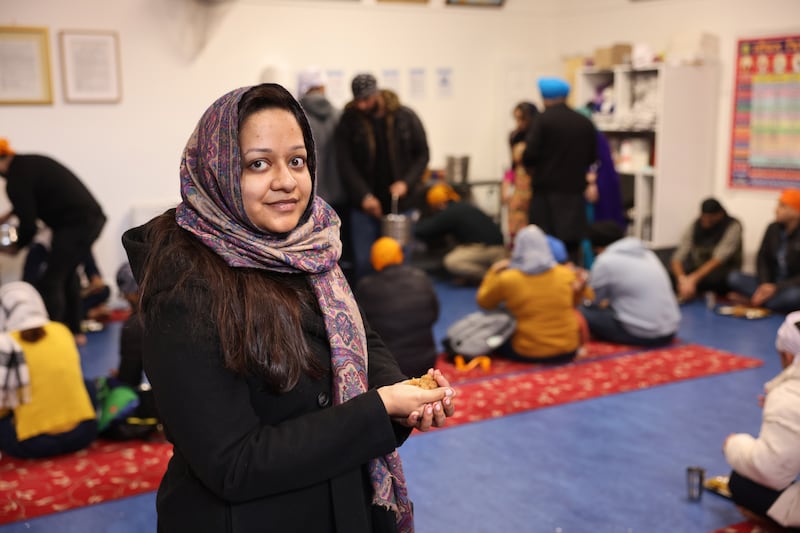
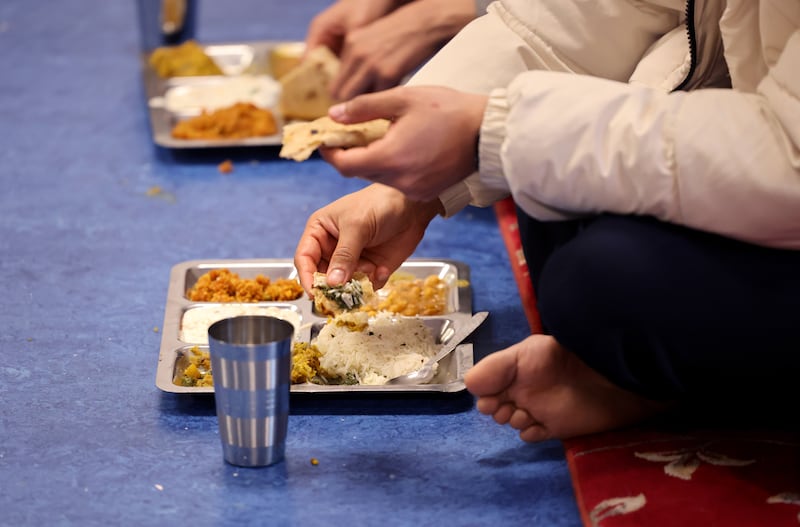
There’s usually a lentil or chickpea curry, a vegetable preparation, salad and yoghurt that volunteers at the Gurdwara dole out. Besides these, a generous amount of rice is spooned on to the steel plates. Rotis (a type of Indian flatbread) are dropped into cupped hands. Those who don’t cup their hands to receive the rotis are lovingly reminded to do so. On special days, there’s dessert and sometimes even tea. Everyone must eat seated on rugs on the floor.
On Sundays, the Gurdwara can have up to 500 visitors, says Singh. “To cater to so many people takes a lot of work on the ground. It’s fulfilling; it’s also very demanding,” he says.
“There’s a public image of langar, whether it’s served during protests or how it was served during Covid. It’s usually a masculine image: people in turbans engaging with the community,” says Gill. “The private, behind-the-scenes version is women in the kitchen talking and laughing together,” she says.
[ Sikh temple offers to cook up to 500 free meals daily for vulnerable familiesOpens in new window ]
While langar is served twice a day on each day of the week, mahaprasad at the Hindu temple run by the Vedic Hindu Cultural Centre Ireland is served on Sundays only. Mahaprasad is a feast that’s offered to the Gods first, and then given out to visitors at the temple.
“One person is in charge of preparing the Sunday mahaprasad, and other volunteers work under her care,” says Dr Hemant Kumar, president of the centre. He hesitates to name the person in charge, saying he doesn’t have her permission.
The different dishes that make up the mahaprasad at the temple are stored in pots in the prayer hall, where large posters of Hindu gods and goddesses cover the walls. Once the Sunday prayers are completed, devotees arrange a plate with mahaprasad and place it in front of the idols of the gods and goddesses. Only after this is done can visitors begin to queue for the meal, which is usually served around 2pm.
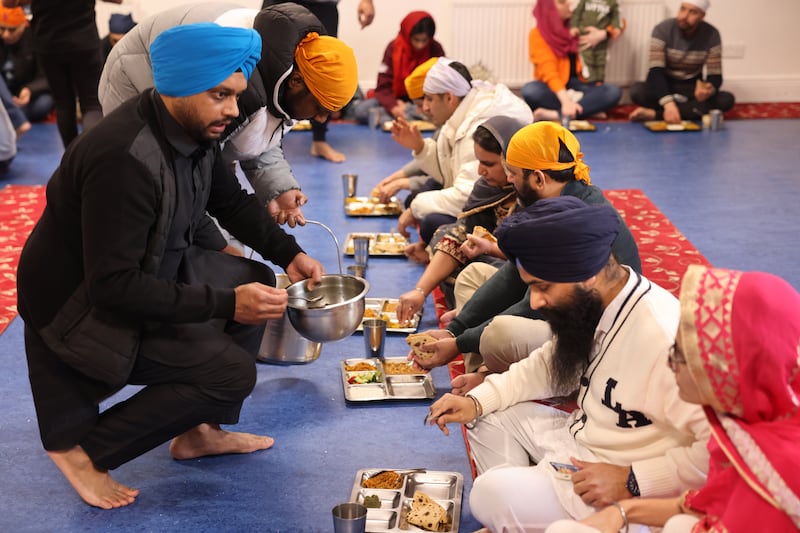
One Sunday in January, volunteers at the temple prepare and serve aloo-gobi (a dry potato and cauliflower preparation), rajma (a spiced kidney bean curry), matar-paneer (a curry with peas and cubes of cottage cheese), rice, pooris (fried flatbread), raita (spiced yoghurt) and kheer (a pudding made with rice and milk). None of the dishes use any onion or garlic, as per Sattvic tradition.
“The meal is always sponsored by someone,” says Dr Kumar. Between 100 and 150 people attend the Sunday prayers, he says.
The International Society for Krishna Consciousness (ISKCON) temple on Abbey Street follows a similar model. “The Sunday feast programme is sponsored by different people every week,” says Manu Dasa, temple administrator. “Sometimes people sponsor it for special festivals, sometimes in the memory of a loved one,” he says.
Prasad is god’s mercy, says Dasa. “It is offered to God first and then we partake in it. It’s a loving exchange. It becomes sanctified after it is offered to god,” he says.
Before the prasad is served, devotees sing kirtan or songs dedicated to Lord Krishna. Part of the Sunday feast programme, the singing begins at 3pm and goes on until 5pm. The prasad is always served at Govinda’s, the vegetarian restaurant below the temple. Visitors queue to receive their respective meals and are then allowed to sit at the tables in the restaurant to enjoy the food. This happens after 5pm.
When you’re in a foreign land, finding a place with people who have similar life experiences is really important. These places are for having conversations with each other, exchanging thoughts and ideas
— Manvinder Gill, a social worker and mental health counsellor from Toronto
On a cold Sunday evening in January, ISKCON volunteers handed out hot vegetable soup, dal (a lentil curry), rice, a dry potato and vegetable preparation, pooris (fried flatbread) and halwa (a pudding made with semolina and sugar), in disposable cups and plates.
“It’s part of our religion to share prasad with others. We cook it with love and devotion,” says Dasa.
While all of these places have kitchens dedicated to preparing prasad, the Ireland Vinayaka Temple in Kingswood, Dublin, relies on devotees who bring in the prasad from their homes. “On an auspicious day, someone sponsors the prasad,” says Shankar Gopalakrishna, who has been a member of the temple’s committee since its inception in 2003.
The prasad here is not served every day, but only on special days, says Gopalakrishna. “Our aim is to have a kitchen,” he says.
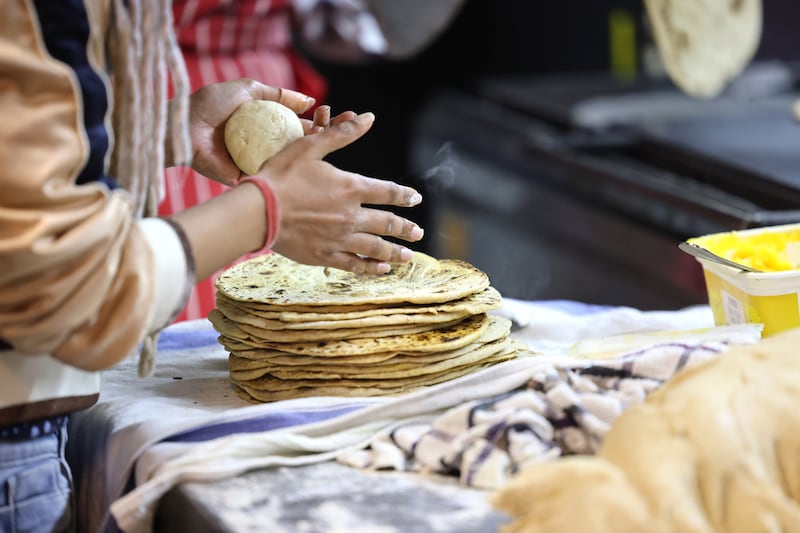
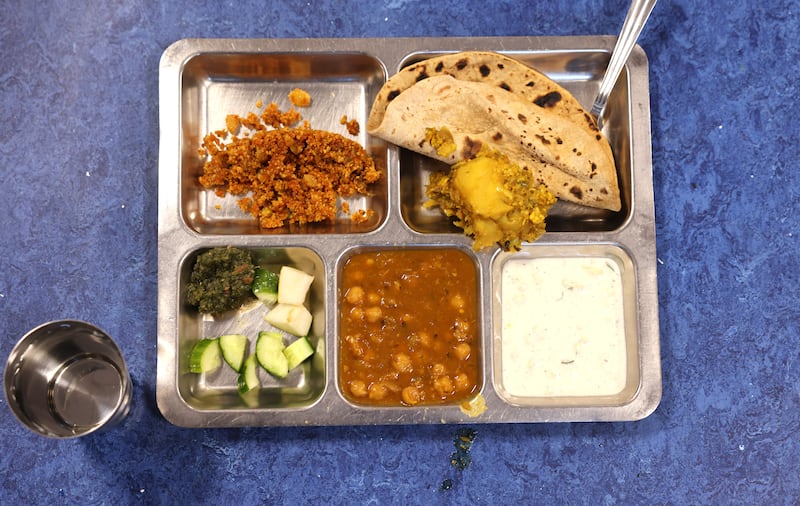
Besides being places of worship, all of these temples have community service in common. “When you’re in a foreign land, finding a place with people who have similar life experiences is really important,” says Gill, a mental health counsellor. “These places are for having conversations with each other, exchanging thoughts and ideas. They are also spaces where you may talk to people and find a place to rent, find a job, and have your basic needs met. People’s mental health is impacted by structural forces,” she says.
Temples, whether Sikh or Hindu, can be conducive to community building and sharing resources. “A lot of students are first-timers at the Gurdwara, and we help them become familiar with the gurdwara protocol. They participate and feel a sense of community,” says Singh, who is a regular visitor at the Gurdwara. “It’s a great place for networking, as people are away from home. Food plays a big part in giving people a sense of home away from home,” he says.
Since everyone is welcome in these spaces, they have a palpable air of acceptance in common. They are all havens for anyone looking to find comfort in religion, or even outside of it.


















